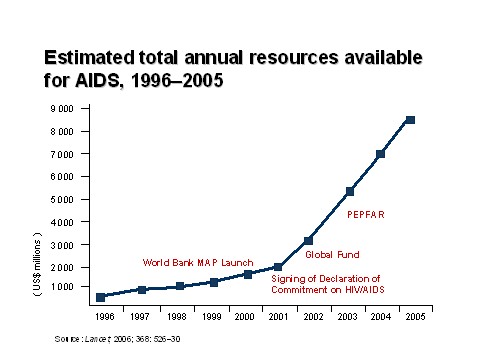 According to the annual UNAIDS and WHO AIDS Epidemic Update released this week, an estimated 39.5 million people are now living with HIV, about the same number as five years ago. There were 4.3 million new infections, also about the same as in 2001. So, is the epidemic getting better, worse or staying the same? Mead Over, an expert on the epidemic who recently joined CGD as a senior fellow, discusses the key findings of the UNAIDS report.
According to the annual UNAIDS and WHO AIDS Epidemic Update released this week, an estimated 39.5 million people are now living with HIV, about the same number as five years ago. There were 4.3 million new infections, also about the same as in 2001. So, is the epidemic getting better, worse or staying the same? Mead Over, an expert on the epidemic who recently joined CGD as a senior fellow, discusses the key findings of the UNAIDS report.
Q: What is the single most important trend you see from this year's UNAIDS report?
A: The growing number of people being treated for AIDS. Energized by the WHO "3 by 5" program to put 3 million AIDS patients on treatment by 2005, and financed by the Global Fund for AIDS TB and Malaria and many other donors, the number of people in poor countries receiving daily anti-retroviral medication for AIDS has risen from a few thousand in 2001 to more than 1.6 million. This is still less than half of WHO's target and less than a quarter of the people that WHO estimates to need treatment. But it is an extraordinary rate of growth of treatment access for a single disease, perhaps unprecedented in the history of the world.
Q. What are the prospects for those now getting treatment?
A: Unfortunately, even in the rich countries and with the best medical care, AIDS is still incurable. The 1.6 million patients placed on anti-retroviral therapy will experience improved health only if they strictly adhere to their treatment regimen every day for the rest of their lives. Those who strictly adhere can expect an additional five to ten years of life on inexpensive generic drugs called "first-line" drugs. For most patients, even with strict adherence, the first-line drugs eventually stop working. Then the patient requires "second-line" drugs in order to survive. And subsequently "third-line" drugs and so on. Each subsequent set of drugs is more expensive than the last, with some of the newest drugs costing tens of thousands of dollars a year.
Q: Were there any big surprises?
A: The number of deaths from AIDS in Sub-Saharan Africa is reported to have increased from 1.9 million in 2004 to 2.1 million in 2006. This is despite the fact that according to WHO one million people in Africa are now receiving anti-retroviral therapy. Since the one million are presumably among the 2 million people who would have otherwise died, one would expect the number of deaths from AIDS to have declined by almost half, not increased as UNAIDS has reported. Does this suggest that the patients are not receiving the benefits that one would have hoped from their AIDS treatment, and are dying despite treatment? Or is one or more of the numbers mistaken? I'll be looking to learn more.
Q: Spending to counter the epidemic is at record levels. Should we expect more progress, given the resources being committed, or is funding still inadequate?
A: The resources committed to AIDS have indeed grown at an extraordinary rate. The following graphic depicting this growth is taken from a recent Lancet article.

The AIDS treatment community is still learning how to spend these resources effectively. Even if resource flows flatten off at current levels, which they do not yet show a sign of doing, the treatment community will play catch up for a few years as it learns how to spend these resources most effectively.
Q: While most new infections occurred in Africa, there has long been concern that other developing regions might follow Africa's path, moving from a concentrated to a generalized epidemic. What does the report say about the spread of the virus in regions such as East Asia, South Asia, Latin America and Eastern Europe and Central Asia?
A: UNAIDS defines (pdf) a generalized epidemic as one "where adult HIV prevalence among the general adult population is at least 1% and transmission is mostly heterosexual" and concentrated one as one "where HIV is concentrated in groups with behaviors that expose them to a high risk of HIV infection.".
There does not appear to be a serious prospect that any country in these regions will develop a generalized epidemic in the next few years. The report does point with alarm to the epidemics in India and China, where surveillance is still insufficient and the number of infections continues to increase. On the positive side, the only two countries with data on the percentage of sex workers infected, Thailand and Nepal, both show sizable declines in that percentage. (From 8.5 to 4.3 in Thailand and from 17.1 to 2.0 in Nepal). However, in those countries with more than one observation on the infection rate among injecting drug users, Vietnam, Thailand and Pakistan, the trend is pessimistic: Vietnam, from 17.5 to 30.6; Thailand no change from 39 and Pakistan zero to 22.9 percent. Infection rates among sex workers and injecting drug users are crucial, since these groups are especially likely to contract and spread HIV.
Q: Are there any country stories that you found particularly alarming or encouraging?
A: The story of treatment expansion is particularly encouraging in Thailand. This story is told in detail in a book that I co-authored, The Economics of Effective AIDS Treatment Evaluating Policy Options for Thailand. We projected treatment expenditures forward twenty years and concluded that treatment is indeed affordable for Thailand - provided that the country strengthens its efforts to prevent new cases.

